Tuesday, January 31, 2006
20:03 -
Rosslyn Chapel- Edinburgh

I am having my portion of influenza. Fortunately it only hit my stomach and my pharynx; dizziness and nausea have almost gone away, however an annoying pain in the back persists.
Rosslyn Chapel, or collegiate chapel of St. Matthew looks like a repository of Christian themes with a specific stress on imagery linked to nature.
Here, in the south aisle, the
works of mercy (or better in the
Cathechism of the Catholic Church at 2447), with a misplacement: the fifth seems to represent avarice misplaced for charity from a similar representation of the seven deadly sins.
Monday, January 30, 2006
21:49 -
Ruminatio (1 of ?)
So, here we are. I read the encyclic and finished the Ecclesiaticus.
I cannot express much about the relationship between eros and agape given my lack of past, present and probably future experience in the subject.
I have, however, some experience in some charitable activity of the Church, which was given voluntarily and free for the glory of the Lord.
I am pleased to read some reference to the laity, being convinced as I am that it is in actual fact the majority of Catholicism.
It is also, in my opinion, the one whose role is less defined, and, in my experience, less respected by the clergy.
Not everybody is called to the service of the Word and Sacraments, and spending more time in those activities does not mean having more opportunities to become saint.
In a world in which Love has become the most disrespected of weaknesses, lay people bear an heavy Cross, having to face the strongest of the oppositions.
Yet such testimony is important: while clergy has the responsibility of the incarnation of the Spirit, it is the laity who has the responsibility to look after Him so that He can grow up and make in this sad reality a suitable place in which Jesus will be able to inhabit when He will return.
The laity has to face the painstaking inertia and slow daily routine of completing the creation, in places and times where it is not possible to withdraw.
I like the style that Pope Benedict uses, it's clear, logical, cathechetical. I'll be looking forward to reading more documents written by him.
21:48 -
Rosslyn Chapel- Edinburgh

This carving is close to the altar to the Blessed Virgin. It is an unfamiliar representation to me especially so close to an altar.
Strangely enough there is no deformity in it, just a fallen creature whose action is restricted.
It made me think to the omnipotence of God, Who all can and how He can bend at His service every event that happens in human history.
When I was participating to the Bible meetings at the Dominicans I had an interesting suggestion from one of the Fathers: there is a jewish legend surrounding the way Solomon built the temple according to which the creatures that built the temple were actually demons summoned and controlled by the king through a magic ring.
I had the opportunity to read something about it on
Google book search. Angelo S. Rappoport collected such legends, but please be careful when you look for such book because he wrote less reliable documents as well.
So there is no place in the creation, on Earth, in Heaven, inside and outside human heart, whatever it happens, in which God cannot express His beauty.
Difficult to see and even more often difficult to accept.
21:45 -
Tomorrow: Don Bosco.
I did not go for many years to an oratory, however I cannot avoid mention
him.
21:38 -
Frozen thoughts
I saw a dead frozen robin today, going to work. I linked it with the following
news.
Sunday, January 29, 2006
12:20 -
In taberna quando sumus...
Burns' night yesterday. My stomac is not ready to digest
haggis, I'll spare you the revolting details.
By the way, it recalled
Babette's Feast to my memory, a Catholic-Protestant encounter. Good film.
Saturday, January 28, 2006
23:24 -
Saint Thomas
I wish to thank Fr. Marcus Holden for his clear and concise insights on the problem of the relationship between the city of God and ours, the good choir that sang in Latin during the Mass, Aelianus and all other people of Living Scotland for their friendly hospitality.
I am with you in my prayers.
23:09 -
Palace of Caserta
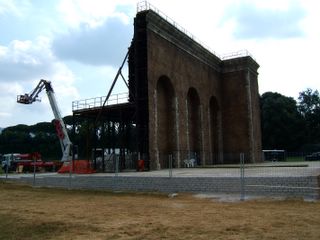
Speaking of films: This structure was built, last summer, near to the gardens of the palace in order to be able to film some of the scenes of last episode of
Mission Impossible (as it can be easily seen from the trailer). I was just passing from there.
00:32 -
Munich.
Or what's the cost of revenge? Good film by Steven Spielberg.
Wednesday, January 25, 2006
19:17 -
I am reading, I am reading.
Interestingly enough it seems that there is already a
Wikipedia entry for the Encyclic.
By the way, dear people at
BBC, how is it that
Eros is written with a starting capital and
agape is not?
Tuesday, January 24, 2006
21:28 -
Sunshine!

Today, for some moment, my desk has been under the light of the sun. It's the first time since November. The day is getting longer, Winter is going to fade... hopefully.
Buying Pixar's DVDs may soon become quite expensive...
Monday, January 23, 2006
21:45 -
It is happening, here and now.
I am no biologist, so that I could write about the point in detail.
An article on Scotsman (13th of January) says that Edinburgh University's prof. Ian Wilmut - who already created Dolly the sheep - is planning to use rabbit oocytes to produce embryos implanting nuclei from human cells, in order to circumvent the lack of human cells for research purposes.
A document of the Church of Scotland already branded the process as unethical asserting that:
In historic Christian tradition, humans are made uniquely in God's image. The mixture of human and animal tissue would breach the distinction which Christian tradition holds between humans and animals.
Personally, I have a couple of questions:
- Would such organism reach a full development if implanted in a womb?
- Would the non-human biologic material used cause a genetic mutation of the cells produced?
I mean, it seems difficult to call this organism 'hybrid', because the nucleus will start commanding the production of human cells, unless there is a genetic modification. But if there is such modification, how helpful can the process be?
Furthermore, it seems to me that the argument used by the Church of Scotland could be used to rule out transplants from animal to human, and I am not sure they would be unethical.
Am I right in thinking that 'conception' is then to be intended as the starting of the development of an organism with human dna, whatever means are used to achieve it?
Is there a good book that explains the problem and the definitions in detail?
21:39 -
Benedetto, Benedetto, Benedetto!
Here a
forum, in Italian, but there is a section in Eglish, German, French and Spanish as well.
From
Il Villaggio Virtuale.
Saturday, January 21, 2006
16:22 -
Diocese Museum - Trento

The life of people who work with computers is similar to those of ancient scribes. Gradually, this powerful instrument is becoming the convergence point of every non manual activity, and, with the arrival of robotics, there is the risk that even those will be subsumed as well.
Internet offers a fantastic window on the entire world, knowledge becomes incredibly accessible; however, as in the non virtual world, there are places worth visiting and places which you avoid.
It's astonishing if you think to the way human beings started to represent and store knowledge and how the process developed.
I am reading an interesting book by Steven Robert Fischer whose title is
"A history of writing". It's very clear, well structured, logically written. From a definition of complete writing and its three distinctive traits follows the story of discovery of writing in Mesopotamy and how from there moved to the rest of the world (the author credits the theory accoding to which writing in China was imported from Europe and from China it probably travelled to the Americas, given the incredible resemblance between chinese and mesoamerican way of modifying and arranging glyphs).
Relationship between phonetics and scripts are explained (e.g. semitic languages have always a consonant at the beginning of a word, at this led greek people to add breathings to an initial vowel when they imported the phoenician alphabet).
It's a good book. Here an excerpt for English readers:
"/θ/ as in thin and /d/ as in this were both written using the single Runic letter /P/, or 'thorn'. Eventually, the letter d was created simply by drawing a line through Latin d - a sophisticated featural distinction. In time, this letter came to be called 'eth'. Scribes still failed to separate the two sounds, however, and so by Middle English a digraph -th- was used for both instead. This we still use today, though graphic th conveys at least two separate phonemes (compare thin and this). Thorn 'p' survives as a cultural remnant in such artificial names as in 'Ye Olde English Inn' in which Y is merely a late mediaeval variant of 'p'"
I am in the process of updating my system (a very time consuming task!), so please do not expect posts this weekend, dear readers.
Thursday, January 19, 2006
22:50 -
Mistery.
One step at a time, when you are discouraged, when you cannot trust anybody around you, when you feel that your energies are limited and everybody around you blindly spins around his self interest, your heart struggles to give you the hope to move another step in opening a new path.
There are moments in which running is hazardous, the way seems blocked and the temptation to give everything up is strong, yet you cannot stop.
Life is a mistery, a beautiful mystery. One step at a time.
Wednesday, January 18, 2006
01:03 -

As a prayer.
Tuesday, January 17, 2006
23:25 -
Vespers
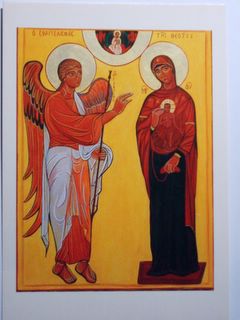
Today, thank to the Dominicans we participated to an Orthodox liturgy. I had already participated to an Orthodox Mass, but today we tried to be together in front of the Lord praying the Vespers. It is not clear to me how it works, because they said that their new day starts with the evening, as for Jewish people.
I see that there are difficulties in starting an ecumenical dialogue. However, I think it is really worth the effort.
The main differences that I noticed in the liturgy is about the use of the the Scriptures, which is definitely more prominent in our Vespers, and the repeated use of the name of Jesus in invocations.
They also used some prayer against the devil, which, honestly, is something that I was missing.
It is definitely worth the effort, but that may be my background.
By the way: the image is a postcard that I received today from an old Jesuit friend.
23:18 -
Lu nemicu di lu demoniu.
It's Saint'Antony of Egypt today. If you have some Catholic reminiscence, you will find the
newsletter familiar.
23:12 -
I like too many things...
| You scored as Philosophy. You should be a Philosophy major! Like the Philosopher, you are contemplative and you enjoy thinking about the purpose for humanity's existence.
Philosophy | | 83% | Engineering | | 83% | Mathematics | | 75% | Chemistry | | 75% | English | | 67% | Psychology | | 58% | Journalism | | 50% | Sociology | | 50% | Art | | 50% | Linguistics | | 50% | Biology | | 33% | Anthropology | | 33% | Dance | | 25% | Theater | | 25% |
What is your Perfect Major? (PLEASE RATE ME!!<3)
created with QuizFarm.com |
From
Zadock.
Monday, January 16, 2006
20:28 -
The Encyclic
According to
Corriere della Sera:
"Dio è amore, chi sta nell'amore dimora in Dio e Dio dimora in lui". Queste parole della lettera di San Giovanni esprimono con singolare chiarezza il centro della fede cristiana, l'immagine cristiana di Dio e anche la conseguente visione dell'uomo e del suo cammino"
These are the starting words of the first Encyclic of Pope Benedict.
I dare a translation:
"God is love; and he that dwelleth in love dwelleth in God, and God in him."(1John 4:16). These words of the letter of Saint John express with singular clarity the center of the Christian Faith, the Christian image of God and the consequent vision of man and his path."
The encyclic itself is in two parts: the first is on the "unity of love, the creation and the history of salvation". The second is about "charitas" as an expression of love by the Church.
They also figure that the Encyclic may be presented on Friday by mons. Josef William Levada and mons. Paul Cordes.
Meanwhile, I am puzzled by the distribution of
μένω.
Sunday, January 15, 2006

It was closed when I arrived, so I could only take pictures from the outside.
The rose window has the right number of columns (there are two of them under each arm of the cross), but a strange number of petals: 8, which is the messianic number.
It seems that the motto of Glasgow derives from a sermon of Saint Mungo: "Let Glasgow flourish by the preaching of the word", trunkating it to the first part only.
I was thinking to this image yesterday, reading chapter 40 of the Ecclesiasticus:
"from the man who wears purple and a crown
to the man clothed in sacking..."
After the passion of Jesus this words have a very different meaning: God conquered our being human without any exclusion.
The image of Mary is there to witness the mistery of the Cross: how is it that when we are called to proclaim the resurrection, we experience the suffering of the Cross?
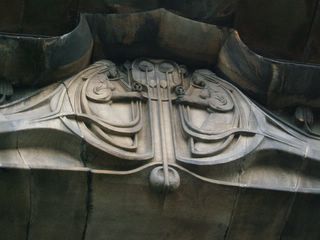
I arrived in Glasgow quite late, so I could only visit the School of Art commissioned in 1896 to Charles Rennie MackIntosh and built in two phases 1897-99 and 1907-09 for the usual funding problems (well, this time was MackIntosh fault).
There is a great difference in the two parts of the building, luminous and refined the first, dark and basic the second. Great use of wood in the first, iron, steel and concrete in the second. As I learn from the description, this is a Free Style building. There is a great use of symbols: shapes and colours look numerically coded. Unfortunately, given that he did not write much about his work, they are undeciphered.
The rose was a leitmotif of the production of MackIntosh. It looks like his wife, Margareth Macdonald, used it to represent a womb, in the Hearth of the Rose. So while a rose window is the interface between the space of God and the space of men, the rose of MackIntosh may represet the interface between inner and outer world of human beings. Where the inner world is the psyche and its symbols, which would reflect the cultural ideas of that time.
Well, this is my opinion, if you appreciate it, please let me know, if you don't, please be respectful as I am.
14:11 -
George Square - Glasgow

Yesterday I spent some hours in Glasgow. The city is different from Edinburgh. The space is distributed differently, the roads are larger and there are larger places in which people can live their social life.
Glasgow presents more opportunities for people who are interested in art.
Saturday, January 14, 2006
23:19 -
Siamo uomini o caporali?
I have not been watching a film of the
Principe Antonio De Curtis for years. It may be the age, but I have to admit that sometimes I need a good laugh the old Italian way.
Old Italian comedy had the powerful and bitter (self) irony of people who had endured the difficulty of the war and survived. Clearly, having watched films from other Countries, I am aware that this is true for every Country had to fight the war, any war.
Monday, January 09, 2006
23:23 -
Rossano - Cathedral.

The icon, painted on plaster and not rock, is as old as the bizantine cathedral (VIII-IX). The title is Achiropita (not painted by human hands).
In actual fact the title of Theotokos (Mother of God) and Odigitria (She who guides) are the most ancient documented.
Individual and collective visions are well documented, especially in difficult times for the city.
Many miracles are attributed to Our Lady in Rossano invoked with the Achiropita title.
In Rossano, in the Museo Diocesano, it is also possible to find the
Codex Purpureus Rossanensis, written in greek: a masterpiece.
Only two pages of the original are on display and they change every year. A remarkable esperience.
23:22 -
The Castle of Scilla.

Just a photo to remember the finished holidays. Today, I saw the big wheel on Princes Street disassembled.
I am a little bit tired, coming back to the chores is not immediate after the break, but I will get used to it in a couple of days.
I feel the need of
ratio, I like logics. I think I will focus on my other blog for some time.
ἔστω δὲ ὁ λόγος ὑμῶν ναὶ ναί οὒ οὔ τὸ δὲ περισσὸν τούτων ἐκ τοῦ πονηροῦ ἐστιν (Mt 5,37).
Friday, January 06, 2006
13:11 -
Rossano - Cathedral
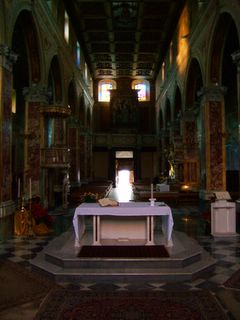
The building has a long story. The original is VI-VII century, maybe related to the monk Efrem.
A second bizantine building was superimposed in the VIII-IX century.
In the XII century it was modified by the Normans (it contains mosaics typical of that period).
An earthquake in 1836 required a major intervention to this and many other buildings in the city.
12:55 -
Cave of Madonna della Stella - Stilo

There are many natural caves in Calabria. They where used by hermits since the first millenium.
They prayed and practised calligraphy offering their life and work to the Lord.
Personally, I think that copying manuscripts was a form of
ruminatio of the Scriptures.
Some of them was proclaimed saint by the Catholic Church. Interactions between the bizantine and latin spirituality were quite strong in the middle ages.
Inside this cave, now, there is a statue of Our lady of the Star. I could not find documentation on why and what star, but it is really a place of the Spirit to be visited with respect.
Wednesday, January 04, 2006
22:23 -
Monastery of Saint John Theristis - Stilo
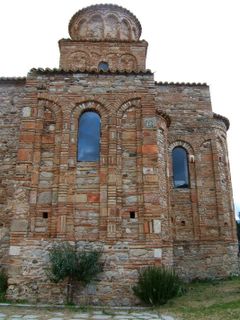
Saint John Theristis (harvester) was born in Palermo, when the Sicily had been conquered by Arabs.
At the age of 14 he moved to Stilo to receive the orthodox baptism. He made many miracles, among which harvesting wheat for the poor.
The monastery had started to be built in 1100 and quickly became the most important in the dioceses of Squillace, already renown because of the Vivarium of Cassiodorus.
The basilian monks (greek-catholics) definitely abandoned it in 1662.
Now it has been given to the ortodox dioceses of Italy, and it is usually visited by the monks of mount Athos.
22:19 -

This is a plant of Caper. As you probably know, it's a great condiment to tomato and fish (cod).
However, its real feature is that it can be found on any old wall in the Mediterranean area, so it can be found on the external wall of the Vatican and the Western wall of the temple in Jerusalem.
A really inter-religious plant!
Monday, January 02, 2006

The statue was moved from the Charterhouse to the Matrice Church after the earthquake in 1783.
Honestly I am not sure whether it represents Saint Bruno, I could not find any confirm about it and there wasn't anybody in the Church.
The Museum of the Charterhouse contains several items related to the story of the building and the life of the monks.
Unfortunately, they are covered by copyright, so I cannot publish the photos on the Internet.
However, if you are planning a journey to Calabria, it is worth visiting.

















